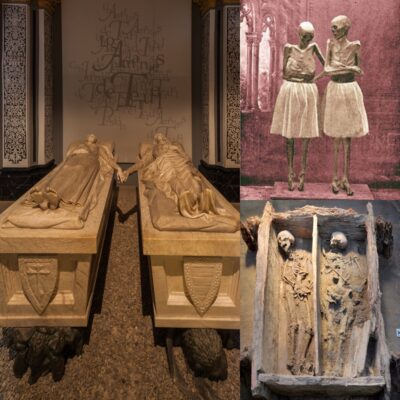You can now step back in time to the 18th dynasty of ancient Egypt (c. 1543–1292) and see King Tutankhamun and the pharaoh’s sacred possessions. Scroll down to see a taste of Cranbrook’s new exhibit which is now open through September 3, 2017.
Story by Edward Pevos of MLive

Photo by Edward Pevos of MLive
More than 100 treasures
The exhibit features 131 replicas of the pharaoh’s sacred possessions and artifacts. These are very detailed and exact replicas of the originals which will no longer be leaving Egypt.

Photo by Edward Pevos of MLive
Ticket info
Tickets are $10 for non-members of the Cranbrook Institute of Science and $9 for members. Kids ages 2-12 are $8.

Photo by Edward Pevos of MLive
Bust of Tut on a Lotus – 18th Dynasty
This portrait captures Tut’s elongated platycephalic skull, a common feature among members of the inbred royal family of Amarna.

Photo by Edward Pevos of MLive
Court sandals – 18th Dynasty
Fashioned of papyrus fiber, leather, wood and sheet gold, some 93 articles of footwear were buried with Tut. The finest example is this pair of sandals found in the Antechamber, packed inside of the painted chest. Made of wood with ornate marquetry veneer, the soles are decorated with the traditional images of captive African and Asian enemies, symbolically trampled with the pharaoh’s every step.
The original sandals can be found at the Cairo Museum.

Photo by Edward Pevos of MLive
Ebony game box & casting sticks – 18th Dynasty
One of Tut’s favorite diversions was playing games of chance. Like many ancient Egyptians, he enjoyed the game of “senet” in which the movement of pawns on a checkerboard was decided by the throw of knucklebones or casting stucks. Of the four game boxes found in the Annex, this one made of wood with ebony and ivory veneer was the finest.

Photo by Edward Pevos of MLive
Royal Mummy of Pharaoh Tutankhamun & Funerary Bier
The much anticipated opening of the third coffin, delayed by the sudden death of Lord Carnarvon, revealed the pharaoh’s mummy which measured 5ft 4in in length.

Photo by Edward Pevos of MLive
Royal Mummy of Pharaoh Tutankhamun & Funerary Bier
Wrapped in linen bandages enfolding over 150 carefully placed sacred jewels and amulets and liberally anointed with consecrated lustrations, his body had been badly damaged. Its brittle tissue withered and blackened by excessive application of the very resins intended to preserve it.

Photo by Edward Pevos of MLive
Royal Mummy of Pharaoh Tutankhamun & Funerary Bier
His face, protected by the gold mask, suffered the least damage. Encircling his head was a royal diadem of gold inlaid with cloisonne and semiprecious stones. His fingers and toes were individually capped with plain gold sheaths and his feet were fitted with a pair of ornamental sandals made of gold.

Photo by Edward Pevos of MLive
As the priceless treasures on Tut’s person were removed, the pharaoh’s fragile remains were senselessly torn to pieces. A second examination of the mummy in 1968 revealed possible evidence of a fatal blow to the skull behind the left ear











